Thwaites Glacier, located in the West Antarctic region, has increasingly become a focal point in climate science discussions, primarily due to its immense size and alarming rate of melting. Roughly equivalent to the land area of Florida, this massive glacier functions as a stabilizing force for the West Antarctic Ice Sheet. Recent research conducted by a collaboration of British and American scientists has revealed concerning information about the glacier’s future, highlighting the potential for rapid melting that could amplify sea level rise significantly over the coming decades. This glacier’s “Doomsday” label reflects not only its scale but also the dire consequences of its potential collapse for global coastal communities.
At the heart of the glacier’s instability is the dynamic interplay between tidal forces and the underlying oceanic conditions. The researchers employed state-of-the-art technology, including torpedo-shaped robots, to probe the sub-ice environment of Thwaites Glacier. Their findings demonstrated that a thin layer of cold seawater currently insulates much of the glacier’s underside from warmer ocean waters. However, as parts of the glacier detach from the seabed, tidal actions introduce warmer water under high pressure, reaching further beneath the ice. This process disrupts the insulating cold water layer, leading to expedited melting at the grounding zone—the area where the glacier meets the seabed.
This disruption is crucial as it accelerates the retreat of the glacier’s grounding line, which serves as a critical threshold. The grounding line’s position is directly linked to the stability of the glacier: retreating further poses risks not only to Thwaites but also to the larger West Antarctic Ice Sheet it supports.
The implications of Thwaites Glacier’s accelerated melting extend far beyond Antarctica. Currently, scientists estimate that if Thwaites were to collapse entirely, global sea levels could rise by as much as 3.3 meters (10.8 feet), drastically altering coastlines worldwide and displacing millions of people. Even a smaller rise of approximately 65 centimeters (about 26 inches) arising from partial melting represents a significant threat, especially considering the current pace of sea-level rise at 4.6 millimeters per year.
Given how interconnected ocean levels are with climate patterns, the potential loss of the Thwaites Glacier should be viewed through a global lens. The regional changes will undoubtedly affect ocean currents, weather systems, and marine ecosystems, exacerbating existing challenges faced by coastal regions, including heightened flooding, erosion, and infrastructure damage.
The Broader Context of Climate Change
Although some computer models suggest that adhering to the emissions reductions proposed in the Paris Agreement may alleviate the situation, the consensus among scientists remains grim regarding Thwaites Glacier’s future. For well over 80 years, the glacier has been in a state of retreat, with the rate increasing sharply over the past three decades. Rob Larter, a marine geophysicist involved in the research, emphasizes that current findings clearly indicate a trajectory towards greater and faster retreat.
Moreover, additional dynamics not currently reflected in larger-scale climate models could further contribute to the glacier’s decline. The interplay between snowfall and ice loss illustrates this imbalance. While heavy snowfalls may temporarily replenish the ice sheet, they are insufficient to counteract the far greater losses currently being experienced.
As global temperatures rise due to greenhouse gas emissions, the moisture levels in the atmosphere are expected to necessitate more precipitation in the form of snow across Antarctica, at least initially. However, experts warn that this could transition to rainfall, further accelerating surface melting alongside the undermining of the glacier from below.
While predictions about the fate of Thwaites Glacier remain uncertain, the ongoing research underscores an urgent need for comprehensive monitoring and innovative climate solutions. The relationship between human activity and climate change is pivotal in determining the glacier’s future. The balance—between mitigating emissions and adapting to changes—will heavily influence scenarios in which we delay or accelerate the destructiveness of sea-level rise. As we stand on the brink of potential climatic tipping points, our collective response will ultimately determine not only the fate of Thwaites Glacier but also the future of coastal communities worldwide.


Leave a Reply